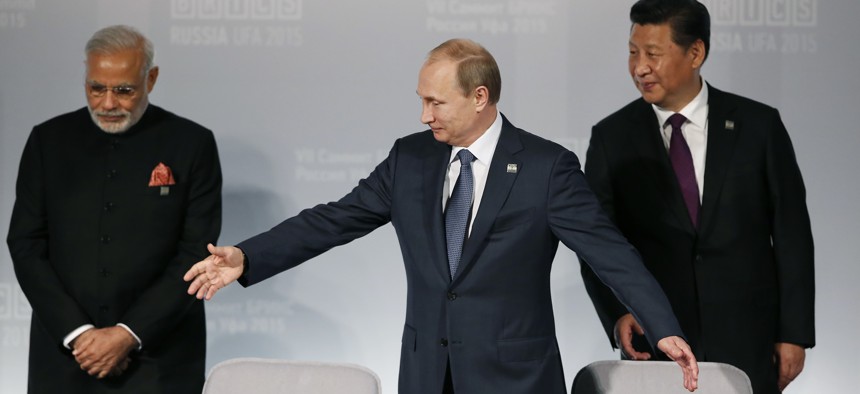
Russian President Vladimir Putin, center, welcomes Indian Prime Minister Narendra Modi, left, and Chinese President Xi Jinping prior signing ceremony at the BRICS Summit in Ufa, Russia, Thursday, July 9, 2015. Sergei Ilnitsky/AP
Global Defense Spending Is Getting Murkier
Many of the governments that are spending more on their militaries are also the least transparent.
Global defense spending is rising—up $675 billion since 2005—and it is increasing fastest where standards of governance and levels of transparency are lowest. If more is not done to ensure basic standards of transparency and accountability, the military capabilities of many emerging powers will become increasingly opaque, unaccountable, and dangerous.
Already, about one-quarter of the world’s governments do not publish their defense budgets, while an estimated more than one-third global military expenditure is by countries with zero meaningful budget transparency at all.
The gap between defense spending and public accountability becomes particularly salient when you combine SIPRI’s new 2015 Trends in World Military Expenditure, released last Wednesday, and Transparency International’s 2015 Government Defence Anti-Corruption Index (GI). This crosscheck reveals, among other things:
None of the top 10 countries with the highest relative increase from in defense spending from 2014-2015 received higher than a D on Transparency International's Government Defence Anti-Corruption Index, which grades countries on a scale from A to F for defense transparency and accountability. Of the 41 countries that spent more than 2 percent of their GDP on defense in 2015, none received an A, while only three received a B. Of the 69 countries that spent more than 5 percent of their government budgets on defense in 2015, only five received an A or B.
Read more: China Is Among the World Leaders in ‘Secret’ Military Spending, Report Says
The new SIPRI report shows that major powers like the United States (which received a B grade from Transparency International), United Kingdom (A), France (C), and Italy (C) have scaled back military spending since 2005. Meanwhile, China (E), Russia (D), India (D), and Brazil (E), are pouring more money into their militaries, increasing defense spending, respectively, by 169 percent, 112 percent, 44 percent, and 43 percent.
This trend is mirrored by shifts in the global arms trade. For example, defense sales from France and Germany (B) decreased 10 percent and 51 percent from 2011-15 compared to 2006-10. But defense exports from China and Russia have grown rapidly, by 28 percent and 88 percent. The new defense players very often lack the basic factors that might serve as policy constraints, such as openness about upcoming arms sales and licensing criteria, public debate of arms export decisions, and clear decision-making structures for export licensing.
Why does transparency matter? Safe and responsive governments require an informed citizenry. Yet across the global defense sector, a lack of transparency and accountability pervades. From arms export controls to budgetary planning, citizens are often denied critical information regarding what their governments are doing.
Moreover, opacity and institutional weaknesses in arms-importing countries facilitates the untracked, uncontrolled movement of weapons across borders, particularly in the Middle East and Africa. This feeds regional insecurity — and provides more reasons to increase defense spending.
How growing players in the defense export market—like India and Brazil—approach the domestic governance of their defense sector will affect regional stability in years to come.
The big question is: in whose interest, and to what end, will all this new military power be governed?




